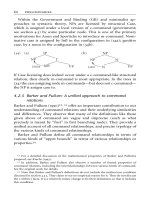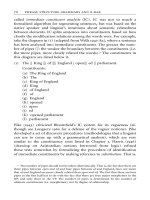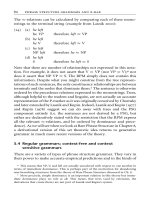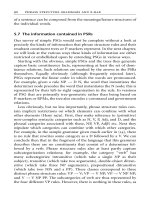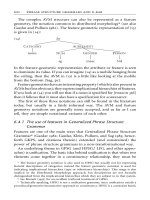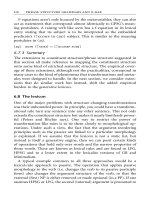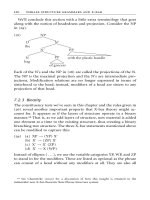Constituent Structure - Part 7
Bạn đang xem bản rút gọn của tài liệu. Xem và tải ngay bản đầy đủ của tài liệu tại đây (115.07 KB, 10 trang )
relations (immediate dominance) in combination with the orderings
of elements among sisters. We will assume that sisters are always
ordered left to right on a single line, so problems like those in trees
like (21) will not arise. This ordering is a primitive.23 We might call the
relation in question here sister-precedence.24
(24) Sister Precedence (0
s
)
Node A sister-precedes node B if and only if both are immedi-
ately dominated by the same node M, and A emerges from a
branch from M that is to the left of the branch over B.
General precedence, then, can be deWned parasitically on sister
precedence:
(25) Precedence (0) Node A precedes node B if and only if
(i) neither A dominates B nor B dominates A and
(ii) some node E dominating A sister-precedes some node F
dominating B (because domination is reXexive, E may
equal A and F may equal B, but they need not do so).
Recall our badly drawn tree in (22). There is a node, NP (¼ E in the
deWnition above), which dominates the N clown, and that NP sister-
precedes the VP (¼ F), which in turn dominates V kissed (NP).
Therefore N clown precedes V kissed.
This deWnition (in particular part ii) also derives a typical restriction on
syntactic: branches may not cross. So trees like that in (26) are disallowed.
()
*M
N
PQ R Z
O
In this tree, Q is written to the left of R, apparently preceding R, but by
the deWnition of precedence given above, this tree is ruled out. Q is to
the left of R, but O, which dominates Q, is sister-preceded by N. In
other words, branches may not cross. We will revisit this issue in
Chapter 10.
23 But might be due to the ordering in the phrase structure rule or other generative
principle of linearization.
24 Sister-precedence is a relation that captures the exhaustive constant partial ordering
(ECPO) insight of GPSG (Gazdar, Klein, Pullum, and Sag 1983), where precedence
relations hold only in local trees and between local trees.
40 preliminaries
3.4.2 Immediate precedence
There is also the local form of precedence: immediate precedence:25
(27) Immediate precedence
A immediately precedes B if there is no node G that follows A
but precedes B.
Consider the string given in (28) (assume that the nodes dominating
this string meet all the criteria set out in (25)):
(28)A B G
In this linear string, A immediately precedes B, because A precedes B
and there is nothing in between them. Contrast this with (29):
(29)A G B
In this string, A does not immediately precede B. It does precede B, but
G intervenes between them, so the relation is not immediate.
Note that immediate precedence and sister precedence are diVerent
relations. This can be seen by looking at the tree in (30):
()M
NOP
QRS
Each of the following pairs of nodes expresses a sister precedence
relation: 0
s
¼ {hQ, Ri, hN, Oi, hN, Pi, hO, Pi}. The set of immediate
precedence relations is diVerent: {hQ, Ri, hN, Oi, hO, Pi, hR, Si}. R
immediately precedes S, but it does not sister-precede it. Similarly, N
sister-precedes P, but it does not immediately precede it.
3.4.3 Axioms of precedence
With these deWnitions in mind, we can now deWne the properties of
these trees axiomatically using Wrst-order logic. First, we need to add
25 To my knowledge there is no standard symbol for the immediate precedence relation.
One might extend the * notion so that 0* means ‘‘general precedence’’ and 0 is limited to
‘‘immediate precedence’’. For the purposes of this book, we will keep with the standard
usage of 0 as general precedence. See Zwicky (1986b) for an argument from Finnish that
immediate precedence is the more important relation.
basic properties of trees 41
the precedence relation26
,
27 to the parts of the mathematical descrip-
tion of trees (6):
(6) (e) the binary precedence relation P (0)onN.
This relation is, of course, constrained by several axioms. First, like
dominance, the relation is transitive:
A6. P is transitive:(8xyz 2 N) [((x 0 y) & (y 0 z)) ! (x 0z)].
That is, if A precedes B and B precedes C, then A precedes C. This rules
out graphs such as (31), where the arrow means ‘‘appears to the left of’’
even though on the page it actually appears to the right:
* ABC
→→
This would be the impossible situation where A is said before B; B is
said before C, yet C is said before A.
We also need to exclude the possibility that a node A both precedes
and follows another B. (I am assuming that we can not say two
diVerent words at the same time28), as in (32) where the arrows indicate
‘‘appear to the left of ’’:
26 As we will see in Chapter 8, Kayne (1994) argues that the precedence relation can be
reduced to asymmetric c-command, and thus need not be part of our formal description of
tree structures. We leave this aside here.
27 Terry Langendoen (p.c.) has suggested that a diVerent characterization of precedence
than the one given here actually allows one to derive a certain number of these axiomatic
statement. Langendoen’s proposal is that terminal nodes are speciWed for a span. This
consists of a pair of numbers, the Wrst is the ‘‘begin’’ integer, the second is the ‘‘end’’ integer.
The two numbers are linked with the symbol
^
. The left-most terminal is speciWed for the
span 0^1, the next to its immediate right is 1
^
2, etc. The rightmost terminal is (nÀ1)^n.
A node N with k daughters spans m
0^
m
k
if and only if N’s daughters span
m
0
^
m1 ... m
kÀ1
^
m
k
. The no-crossing constraint is the requirement that every node in
the tree have a span in this sense. Immediately precedes is deWned as the relation that holds
between nodes A and B, when the end(A) ¼ begin(B). Precedes is simply the case where
end(A) # begin(B). The fact that precedence represents a strict ordering (i.e. is irreXexive,
asymmetric and transitive) falls out naturally from this deWnition. Langendoen even
suggests that domination can be deWned in terms of these spans, where the span of a
dominator contains the spans of the daughters. For example, if A dominates B, then
begin(A) # begin(B) & end(A) # end(B). This proposal is an interesting alternative.
I do not have the space here, however, to consider what empirical advantage (if there is
one) it has over the more usual relation speciWed in the main body of the text.
28 This assumes, of course, a purely acoustic medium for language. In principle,
although it doesn’t appear to happen in practice (Senghas p.c.), in a signed language one
might be able to sign two words simultaneously.
42 preliminaries
() * AB
As such, precedence is asymmetric:
A7. P is asymmetric:(8xy 2 N) [((x 0 y) !:(y 0 x)].
It follows from this, then, that precedence is not reXexive (T1), because
if you were allowed to precede yourself, then you would also be allowed
to follow yourself. This situation would be contradictory to (A7).
T1. PisirrreXexive:(8x 2 N) [:(x 0 x)].
One hypothesis about the relations P and D is that they represent a
total ordering of the elements in the set N. As such, we claim that P and
D are mutually exclusive (if x precedes y, x cannot dominate y and vice
versa). This was encoded in part (i) of the deWnition of precedence
given in (25), we restate this here as (A8):
A8. Exclusivity condition:29 8xy 2 N) [((x 0 y) _ (y 0 x)) $:
((x /*y)_ (y /* x))].
The second part of the deWnition of precedence given (25) can also be
viewed axiomatically. This is the so-called non-tangling condition of
Wall (1972), which derives a basic assumption of Chomsky (1975): there
are no discontinuous constituents.30
A9. Non-tangling condition:(8wxyz 2
N) [((w 0
s
x) & (w /*y)
&(x/* z)) ! (y 0 z)].
Schematically, (A9) represents a structure like that in (33a), not the one
in (33b), thus ruling out crossing lines.31
29 Zwicky and Isard (1963) originally state this as a condition whereby precedence is
deWned only over sisters.
30 Higginbotham (1985) states this constraint over terminals (I have rephrased his
formulation slightly here):
(i) x 0 y $ x /* u and y /* v jointly imply u 0 v for all terminals u, v.
In Carnie (2006c), I informally present the non-tangling constraint as the no-crossing-
branches constraint:
(ii) No-crossing-branches constraint
If one node X precedes another node Y then X and all nodes dominated by X must
precede Y and all nodes dominated by Y.
See also Ga
¨
rtner (2002) and references therein.
31 The prohibition against crossing lines is also found in autosegmental phonology. See
Goldsmith (1976), McCarthy (1979), Pulleyblank (1983), Clements (1985), Sagey (1986,
1988), and Hammond (1988, 2005) for discussion.
basic properties of trees 43
(a)
p
(b)
*
p
wx w
x
y
zzy
Interestingly, this condition also rules out multiply mothered nodes
such as that represented in (34) (which we ruled out using (A5)inin
section 3.3.2):
*
a
wx
y
For the purposes of (A9), y ¼ z in (34) (that is, y is dominated by w, y is
dominated by x,andw precedes x). According to (A9) then, this entails
that y 0 y for (34). However, this is in direct contradiction to (T1), which
disallows nodes from preceding themselves. Therefore, (34) is ruled out
by a combination of (A9)and(T1) (which itself follows from the more
basic (A7)). As such, (A5)isasuperXuous part of the description of tree
structures and can be omitted from our axiomization.
3.5 Concluding remarks
The discussion in this chapter has characterized the two most basic
relations in tree-based constituency representations, dominance and
precedence, in terms of an axiomization in terms of Wrst order logic
and set theory. This gives us a precise starting point for comparing
various approaches to constituency. The primary relation is domin-
ance, which expresses the containment properties of hierarchical con-
stituency. Precedence is deWned relative to dominance relations. We
looked at a number of axiomatic properties of these relations. While
many of these are universally assumed, some are not. For example, we
will see in later chapters that the requirements of single rootedness,
single motherhood, the ban on crossing lines, the ban on acyclic graphs
all have their detractors. Indeed, it is the issue of interpreting these
basic notions that often lies at the heart of the fundamental diVerences
among syntactic frameworks. In the later chapters of this book, we
examine the various mechanisms at work in determining constituent
structure, and we will see all of these properties questioned.
44 preliminaries



